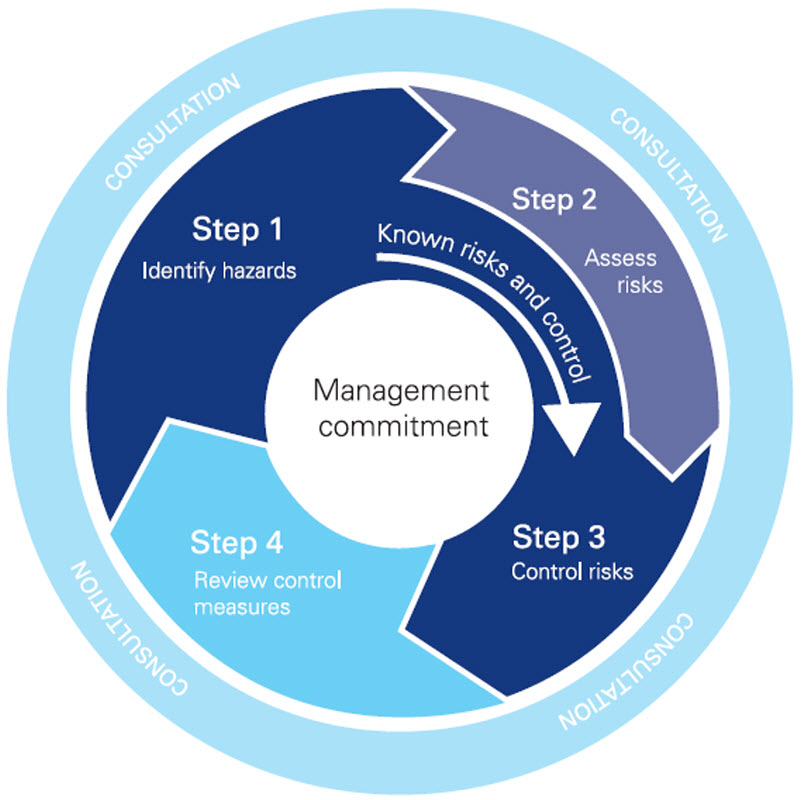A risk management approach to work-related stress: Tip sheet 2
Risk management is a four-step process for controlling exposure to health and safety risks associated with hazards in the workplace: tip sheet 2
Risk management is a four-step process for controlling exposure to health and safety risks associated with hazards in the workplace.
The Work Health and Safety Act 2011 imposes a legal duty on a person conducting a business or undertaking (PCBU) to do what is reasonably practicable to eliminate or minimise risk to worker health and safety. This duty extends to protecting workers from the risk of harm from stressors at work.
Many of the discussions about stress risk management have traditionally been focussed on individuals within a business or undertaking who are already distressed. This approach is not only costly, but it also means that the PCBU may not be fully meeting their duty to eliminate or minimise risks to worker health and safety from being exposed to stressors at work.
The risk of work-related stress may be present in any workplace. PCBUs should apply the risk management process (illustrated in figure 1) to eliminate or minimise, as far as reasonably practicable, exposure to potential causes of work-related stress.
Figure 1: The four-step risk management process

Image based on diagram from How to Manage Work Health and Safety Risks Code of Practice 2011
Step 1: Identify the hazards
The first step in the risk management process is to identify workplace hazards. This means looking for those things in the workplace that have the potential to cause harm. Sources of work-related stress may be determined by evaluating: productivity levels, rates of absenteeism, separation rates/turnover, exit interviews, worker engagement/morale, customer feedback, peak/seasonal demands and analysing incident reports and data trends.
Step 2: Assess and prioritise the risk
This step involves assessing the likelihood and consequences of injury or illness that may result from exposure to work-related stressors. Stressors or risk factors for work-related stress include:
- high work demands (emotional, mental, physical)
- low control
- poor support
- lack of role clarity
- poorly managed change
- poorly managed relationships
- low levels of recognition and reward
- organisational injustice
How to conduct a risk assessment
Risk factors for work-related stress can be assessed by understanding worker complaints, observing interactions between workers, gaining feedback from workers, having one-on-one discussions with workers and through the use of focus groups or a worker survey.
Focus groups are small groups (typically 6–10 people) from across the PCBU. The purpose of a focus group is to provide a forum for assessing the risk of exposure to work-related stressors. This is done by considering each of the stress risk factors listed above and how they may or may not apply to their workplace.
Another effective approach to finding out about work-related stressors is to administer a worker survey. Surveys can be an important tool in soliciting which stressors are present in the workplace, evaluating the degree to which they are affecting workers and pinpointing where they are originating. When undertaking a worker survey, one must consider the size of the group to be surveyed, how participants are to be selected and how survey results will be fed back to workers. Anonymity must be guaranteed throughout the entire process.
Findings from focus groups or worker surveys would then inform a decision about the likelihood and consequences of injury or illness from exposure to work-related stress and make it clear which risk factors are contributing to that risk.
Step 3: Control risks
After assessing the risk and determining which factor(s) have the greatest contribution to that risk, the most appropriate control measure(s) that are reasonably practicable in the circumstances need to be selected and implemented. When selecting a particular control, it is important to be able to justify why it was chosen over a different measure.
For work-related stress, deciding on control measures usually means altering a problem risk factor. For instance, reducing work demands, increasing the level of control a worker has over his or her job, and increasing the amount of peer and/or supervisor support a worker is receiving.
Examples of control measures to manage the risk of work-related stress may include:
- improving supervisor/managerial skills through coaching, mentoring and/or training
- planning workloads to meet potential demands
- setting clear performance goals/accountability
- ensuring role clarity and reassessing job descriptions
- setting new or adjusting current HR procedures
- providing assistance (eg an employee assistance program)
- communicating policy and availability of assistance
- checking understanding and implementation of changes
- promoting effective early rehabilitation
Step 4: Review control measures
The last step of the risk management process is to review the effectiveness of the control measures that have been implemented to ensure they are working as planned. When reviewing the effectiveness of control measures, it is important to weigh up whether the chosen controls are effective or whether they need some modification.
Risk management for work-related stress is not a one-off exercise, but something that must go on continually in the organisation. The dynamics and complexity of organisations can mean that changes such as a new supervisor, new workers or new processes or procedures can have marked, unexpected and unplanned effects on the stress levels of workers.
This tip sheet is one of 12 that refer to work-related stress.
- Overview of work-related stress
- A risk management approach to work-related stress
- Implementing a work-related stress risk management process
- Risk factors for work-related stress
- Work demands and work-related stress
- Levels of control and work-related stress
- Support from supervisors and/or co-workers regarding work-related stress
- Role clarity, role conflict and work-related stress
- Managing relationships and work-related stress
- Recognition and reward – minimising work-related stress
- Managing change and work-related stress
- Organisational justice and work-related stress
This document was developed by Workplace Health & Safety QLD, Department of Justice and Attorney General worksafe.qld.gov.au
SW08361 0816